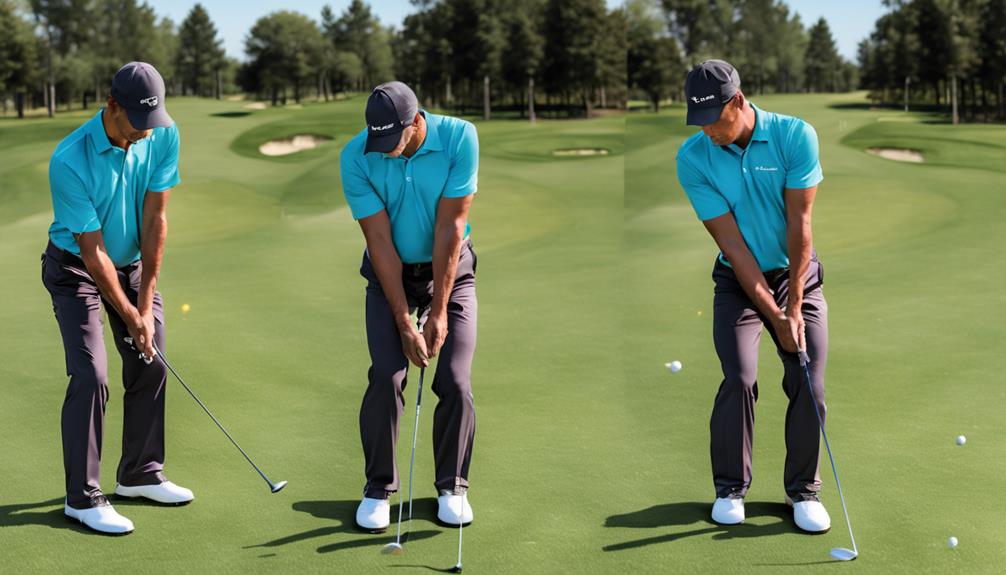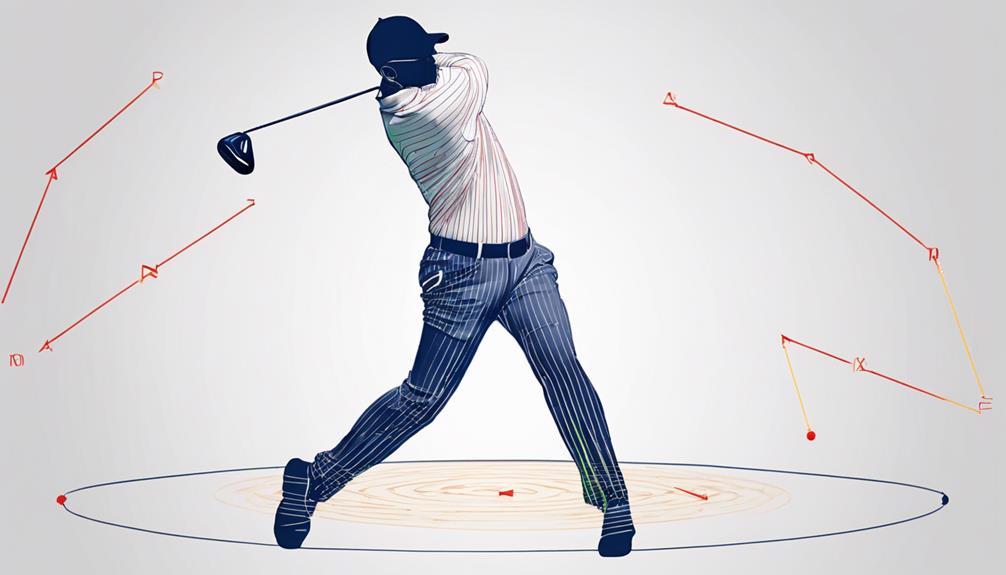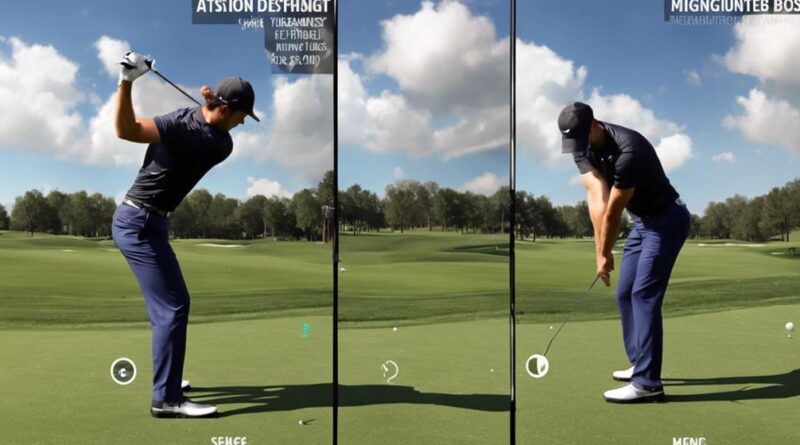10 Best Ways Biomechanics Enhance Your Golf Performance
Improve your golf game with biomechanics! Optimize body movements for better swing coordination. Identify areas for mechanics enhancement and understand muscle activation timing. Transfer weight correctly for more power and work on flexibility and core strength. Enhance energy transfer within your kinetic chain for a dynamic swing. Focus on body alignment precision and stability to increase power and accuracy. Strengthen your core and improve posture for better balance. Use leverage to boost clubhead speed and control distance. Prevent injuries by refining mechanics and managing loads. Work on timing, mental focus, and rhythm for synchronized play. Master the details for peak performance!
Improved Swing Efficiency
To enhance golf performance, biomechanics can optimize swing efficiency by analyzing and improving the coordination of body movements. Swing mechanics play a crucial role in determining the quality of your shots. By utilizing biomechanical analysis, you can identify areas where your swing mechanics may be lacking, leading to inconsistencies in your performance. Understanding the intricacies of swing mechanics allows you to make targeted adjustments that can significantly enhance your overall efficiency on the golf course.
Muscle activation is a key component of achieving optimal swing efficiency. By studying how different muscles are activated during the golf swing, biomechanics can pinpoint opportunities for improvement. For example, focusing on activating the core muscles at the right moment can greatly enhance the power and accuracy of your swing. Through detailed analysis, biomechanics can provide insights into the timing and sequencing of muscle activation, leading to more consistent and powerful swings.
Furthermore, biomechanics can help you refine your technique by ensuring that your body movements are in sync with each other. Coordination plays a vital role in generating a smooth and efficient swing. By examining the timing and alignment of body movements, biomechanics can help you eliminate any unnecessary or inefficient motions that may be hindering your performance. This optimized coordination can lead to a more fluid and powerful swing, ultimately improving your overall golf game.
Increased Power Generation
Enhancing power generation in your golf swing involves maximizing the coordination and activation of key muscle groups to drive optimal performance. To achieve this, focus on the following key elements:
- Proper Weight Transfer: Initiating the downswing with a proper weight shift from the back foot to the front foot is crucial for generating power. This transfer of weight allows you to efficiently transfer energy from your body to the clubhead, resulting in increased clubhead speed and distance.
- Flexibility Training: Improving your flexibility through targeted exercises can enhance your range of motion, allowing for a fuller and more efficient swing. This increased flexibility enables you to coil and uncoil your body effectively, leading to a more powerful and fluid swing motion.
- Hip Rotation: Maximizing hip rotation during the swing is essential for generating power. Engaging and rotating your hips correctly helps to store energy on the backswing and unleash it efficiently on the downswing, translating into increased clubhead speed and longer shots.
- Core Strength: A strong core provides stability and power throughout the golf swing. Strengthening your core muscles not only improves your balance and control but also enhances your ability to transfer energy from your lower body to the club, resulting in greater power generation.
Enhanced Kinetic Chain Function
Boosting golf performance hinges on optimizing the efficiency of your kinetic chain function, a crucial element that facilitates the seamless transfer of energy throughout your body for superior swing dynamics. The kinetic chain in golf involves the coordination of various body segments, including muscles, joints, and nerves, working together to produce an efficient and powerful golf swing.
To enhance your kinetic chain function, focus on muscle activation and joint stability.
Muscle activation plays a vital role in the kinetic chain by ensuring that the right muscles are firing at the right time during the golf swing. Proper muscle activation leads to increased power generation and more consistent ball striking. By engaging the correct muscles, such as the glutes, core, and rotator cuff muscles, you can improve your swing mechanics and generate more clubhead speed.
Joint stability is another essential component of the kinetic chain in golf. Maintaining stability in your joints, especially the hips, spine, and shoulders, is crucial for transferring energy effectively from the ground up through the body and into the club. Improving joint stability through targeted exercises and proper body mechanics can help you achieve a more fluid and powerful golf swing.
Incorporating exercises that promote muscle activation and joint stability into your training routine can significantly enhance your kinetic chain function, leading to improved golf performance and overall consistency on the course.
Optimal Body Alignment
Achieving optimal body alignment in golf requires precise positioning of your key body segments to maximize power and accuracy in your swing. When it comes to enhancing your golf performance through biomechanics, focusing on body alignment is crucial.
Here are some key factors to consider:
- Posture Correction: Proper posture ensures that your body is in the optimal position to generate power and maintain balance throughout your swing.
- Equipment Analysis: Analyzing your equipment, such as the length and lie angle of your clubs, can help ensure that your body alignment is in sync with your gear for the most effective swing.
- Muscle Activation: Engaging the right muscles at the right time is essential for maintaining proper body alignment and generating the necessary power for a successful swing.
- Foot Positioning: The positioning of your feet sets the foundation for your body alignment. Ensuring that your feet are correctly placed can help you maintain balance and stability during your swing.
- Alignment Check: Regularly checking your body alignment during practice sessions or with the help of a golf instructor can help you make necessary adjustments for improved performance.
Enhanced Stability and Balance
To improve your stability and balance in golf, focus on refining your body positioning and weight distribution throughout your swing. Core strength plays a crucial role in maintaining stability during your golf swing. A strong core allows you to transfer power efficiently from your lower body through to your upper body, promoting a more stable swing. Engaging in exercises that target your core muscles, such as planks, Russian twists, and leg raises, can significantly enhance your stability on the course.
Flexibility is another key component in achieving stability and balance in golf. Adequate flexibility in your muscles and joints enables you to achieve the proper range of motion in your swing, helping you maintain balance throughout the entire movement. Incorporating dynamic stretches and yoga into your fitness routine can improve your flexibility, allowing for a smoother and more controlled swing.
Posture and coordination are essential factors to consider when aiming to enhance stability and balance in your golf game. Maintaining a solid posture throughout your swing ensures that your body is properly aligned, reducing the risk of swaying or losing balance. Additionally, coordination between your upper and lower body movements is vital for a synchronized and balanced swing. Practicing drills that focus on integrating your body's movements can help improve your overall stability and balance on the course.
Improved Clubhead Speed
Enhancing your clubhead speed in golf requires optimizing your swing mechanics and leveraging biomechanical principles. By focusing on key aspects such as swing mechanics and muscle activation, you can significantly improve your performance on the course.
- Proper Sequence: Initiating the downswing from the ground up, starting with the legs, followed by the hips, and finally the arms, can maximize clubhead speed.
- Rotational Power: Enhancing your ability to rotate your body efficiently can generate more power and speed during the swing.
- Leverage: Understanding how to use leverage in your swing can help increase the speed at which the clubhead travels through impact.
- Muscle Coordination: Coordinating the activation of different muscle groups in a sequential manner can lead to a more powerful and faster swing.
- Timing and Tempo: Finding the right balance between speed and control, and maintaining proper timing throughout the swing, is crucial for achieving optimal clubhead speed.
Enhanced Distance Control

Maximizing your control over distance in golf entails precise application of biomechanical principles to your swing mechanics, ensuring consistency and accuracy in your shots. Enhanced distance control is the hallmark of a skilled golfer, relying on precision accuracy and consistent performance to navigate the course effectively. By integrating biomechanics into your game, you can achieve fine-tuned control over your shots, allowing for a strategic approach to each swing.
Biomechanics plays a crucial role in enhancing distance control by optimizing your body movements to generate the desired shot outcome. Through a deeper understanding of how the body interacts with the golf swing, you can refine your technique to achieve the perfect balance between power and accuracy. This fine-tuned control is essential for mastering various shots, from long drives to delicate approaches around the green.
Furthermore, a strategic approach to distance control involves leveraging biomechanical insights to tailor your swing to different situations on the course. By analyzing factors such as stance, grip, and body alignment, you can make precise adjustments to optimize your performance. Consistency in applying these biomechanical principles fosters a reliable and repeatable swing, leading to improved distance control and overall proficiency in your game.
Reduced Risk of Injury
How can biomechanics contribute to reducing the risk of injury in golf?
Biomechanics plays a crucial role in analyzing the body movements and mechanics involved in the golf swing, leading to the development of prevention techniques that can significantly decrease the likelihood of injuries and promote performance longevity.
- Optimizing Swing Mechanics: By using biomechanical analysis, experts can identify inefficient or risky movement patterns in your swing that may put excessive strain on certain joints or muscles, leading to potential injuries.
- Improving Body Mechanics: Understanding how your body moves during the golf swing allows for targeted exercises and drills to enhance flexibility, strength, and stability in key areas, reducing the risk of overuse injuries.
- Customizing Equipment: Biomechanical evaluations can help determine the most suitable golf equipment for your body mechanics, such as club length, grip size, and shaft flexibility, ensuring proper alignment and reducing the risk of strain.
- Monitoring Load Management: By tracking biomechanical data, coaches and players can better manage training loads to prevent overtraining and fatigue, which are common precursors to injuries.
- Implementing Recovery Strategies: Utilizing biomechanics, golfers can adopt personalized recovery techniques that aid in muscle recovery, reduce inflammation, and improve overall physical well-being, ultimately enhancing performance longevity.
Improved Timing and Rhythm

To enhance your golf performance, understanding the biomechanics of improved timing and rhythm is essential for optimizing your swing efficiency and power output. When it comes to golf, timing and rhythm play a crucial role in achieving a consistent and powerful swing. By delving into the realm of biomechanics, you can fine-tune these aspects to elevate your game to new heights.
One key aspect of improved timing and rhythm is tempo analysis. This involves breaking down your swing into its individual components and assessing the speed at which each part is executed. A proper tempo ensures that your body and club move in harmony, leading to a smoother and more controlled swing. Through biomechanical analysis, you can identify any discrepancies in your tempo and make the necessary adjustments to achieve optimal synchronization.
Furthermore, swing synchronization is another fundamental element in enhancing your timing and rhythm. This entails coordinating the movements of your body and club throughout the swing sequence. Biomechanics can provide valuable insights into how different parts of your body should move in unison to generate maximum power and accuracy. By honing your swing synchronization, you can achieve a more fluid and efficient swing motion that translates into improved performance on the golf course.
Enhanced Mental Focus
Enhance your mental focus in golf by incorporating biomechanical principles to optimize your cognitive performance on the course. When it comes to golf, mental clarity and focus techniques are essential for achieving peak performance. By understanding how biomechanics can enhance your mental focus, you can take your game to the next level.
- Visualization: Use biomechanical principles to visualize your shots before executing them, enhancing your mental clarity and focus on the course.
- Breathing Techniques: Implement proper breathing techniques to regulate your body's movements and maintain focus throughout your game.
- Mindfulness Practice: Engage in mindfulness exercises that align with biomechanical principles to improve your concentration and awareness during each shot.
- Pre-Shot Routine: Develop a pre-shot routine that incorporates biomechanical cues to help center your focus and prepare your body for optimal performance.
- Posture Alignment: Utilize biomechanical insights to ensure your posture alignment promotes mental focus and stability throughout your swing.
Frequently Asked Questions
How Can Biomechanics Help Prevent Common Golf-Related Injuries?
To prevent common golf-related injuries, biomechanics focus on analyzing your swing mechanics for inefficiencies that may strain your body. Injury prevention techniques involve optimizing your posture, alignment, and movements to reduce stress on joints.
Can Biomechanics Analysis Improve My Overall Golf Technique?
Analyzing biomechanics can greatly enhance your golf technique. By evaluating swing mechanics and muscle activation patterns, you can pinpoint areas for improvement.
Understanding how your body moves during a swing can lead to adjustments that optimize power and accuracy. Biomechanics analysis provides valuable insights into your golf performance, allowing you to make precise changes that can elevate your game to the next level.
What Role Does Biomechanics Play in Enhancing Mental Focus During Golf?
Enhancing concentration in golf relies on biomechanics to optimize your movements for efficiency. By analyzing your body's mechanics, you can develop a more consistent swing, reducing mental distractions caused by physical inconsistencies.
This improved coordination leads to enhanced mental acuity on the course, allowing you to focus more on your game strategy rather than compensating for biomechanical flaws. Ultimately, biomechanics play a crucial role in sharpening your mental focus during golf.
Are There Specific Biomechanical Drills That Can Be Incorporated Into Practice Sessions?
To refine your golf skills, focus on swing mechanics and body alignment. Incorporating specific biomechanical drills can enhance your practice sessions.
Work on your posture, foot positioning, and hip rotation for improved swing power and accuracy. By analyzing your movements and making adjustments, you can fine-tune your technique for better performance on the course.
Consistent practice with attention to biomechanics will help you develop a more efficient and effective golf game.
How Can Biomechanics Assist in Maintaining Consistent Clubhead Speed Throughout a Round?
To maintain consistent clubhead speed in golf, biomechanics can be crucial. Swing efficiency ensures energy transfer at optimal levels, enhancing performance. Proper muscle activation and timing coordination are key elements.
Conclusion
By utilizing biomechanics in your golf game, you can significantly enhance your performance. From improving swing efficiency and power generation to enhancing stability and balance, biomechanics offer a multitude of benefits.
Not only does it reduce the risk of injury, but it also improves timing, rhythm, and mental focus.
By incorporating biomechanical principles into your training regimen, you can elevate your game to new heights and achieve optimal results on the golf course.
